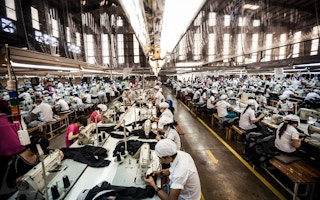Until quite recently, businesses didn’t have a reason to dig deeper than assessing the price and appearance of the products shipped to their warehouses. But the reality of buyer-driven global supply chains means their decisions on price and the suppliers they select dictate conditions for workers across their entire supply chain.
My research with procurement and supply chain professionals in Australian businesses shows that most businesses still largely underestimate their role in eradicating modern slavery from their supply chains.
These businesses could use their position as a “focal” company with strategic intent and foresight, to improve working conditions in their supply chains. By developing close relationships with suppliers, businesses can work out the causes of slavery, apply standards and enforce these with whistleblowing practices.
According to the global slavery index, it’s estimated up to 4,300 people work under slave-like conditions in Australia but worldwide an estimated 45 million people are affected by modern slavery in some form; most of them are workers in South-East Asia.
The federal government is proposing Australian businesses report annually on what they are doing to eradicate slavery in their supply chains. But businesses don’t have to wait for government intervention to improve their practices.
Auditing suppliers overseas
The speed of modern transactions and drive for lower costs have resulted in tender processes that don’t allow for a thorough look at suppliers’ labour practices. It also means there’s more of an arms-length buyer/supplier relationship rather than collaboration between the two parties.
If businesses developed closer relationships with their suppliers, there would be an opportunity to conduct social responsibility audits. I can give example from the apparel sector, from my experience with this industry. Through engaging closely with their suppliers, progressive companies Patagonia and Tatonka recognised that seasonal sub-contracts aimed at getting a line ready for the market at the start of summer or winter put economic constraints on their sub-contractors.
These suppliers struggled to maintain their factories and pay salaries throughout the rest of the year, leaving workers vulnerable. To overcome this, they changed production schedules to a more even spread of production throughout the whole year. This stabilised economic conditions for the factories and subsequently allowed workers to receive a stable income.
Businesses don’t have to tackle this issue alone. There are NGOs, such as the International Labour Organization (ILO), who work on the ground in the areas where suppliers are operating. In fact, the ILO has established a set of criteria in their declaration on fundamental principles and rights at work that help businesses to detect risks of modern slavery in their supply chains.
The criteria includes standards on health and safety, rates of injury, occupational diseases, lost days, and absenteeism. It also requires businesses to record the total number of work-related fatalities and includes criteria for fair notice periods on operational or other changes to employment.
Businesses can also review the role of their own procurement and supply chain professionals, adjusting hiring practices and performance criteria for the role, and reviewing internal reporting structures.
Standards in supply chains
There are standards for the treatment of migrant workers, that align with domestic occupational health and safety standards, in supplier contracts. Any business operating in Australia has an obligation towards its employees to guarantee safe workplaces.
Under the Australian Workplace Health and Safety Act, businesses are responsible to look for situations that have the potential to cause harm or damage - and they are required to do something to prevent incidents from happening within the boundaries of their organisation. But at this stage, workplace conditions at overseas suppliers’ plants are not covered by the Act.
The electronics industry in particular has been under heavy scrutiny for the use of forced labour. To improve this, Dutch phone maker Fairphone sources the required minerals, such as gold, from fair-trade mines.
Fairtrade International established an auditing and certification scheme to help particularly artisanal and small-scale miners to improve working conditions, and to help companies and customers to buy slavery-free minerals with confidence.
“
By developing close relationships with suppliers, businesses can work out the causes of slavery, apply standards and enforce these with whistleblowing practices.
Whistleblowing in supply chains
Establishing whistleblower frameworks sends a strong signal to employees that they are encouraged to come forward to company authorities when they experience or witness anything that can be suspected as forced labour or a form of slavery. Frameworks like this allow the business to rectify the situation internally, and to avoid a full-blown public scandal.
Whistleblowing frameworks are a double-edged sword when it comes to slavery in supply chains. While it might make it easier for domestic employees to report issues, they hardly have the capacity to protect forced workers at overseas suppliers’ plants who decided to speak up about working conditions.
Large businesses, Qantas and Wesfarmers, announced they would establishing whistleblower reporting and investigation frameworks in 2015. But the details on how these work are still not publicly available.
![]() Any proposed solution to eliminating modern slavery from supply chains ironically does not need to start with looking at the suppliers, but needs to begin with an interval review of a business’ procurement department or division. Change must come from within the business.
Any proposed solution to eliminating modern slavery from supply chains ironically does not need to start with looking at the suppliers, but needs to begin with an interval review of a business’ procurement department or division. Change must come from within the business.
Julia Benkert is Lecturer at Swinburne University of Technology. This article was originally published on The Conversation.











